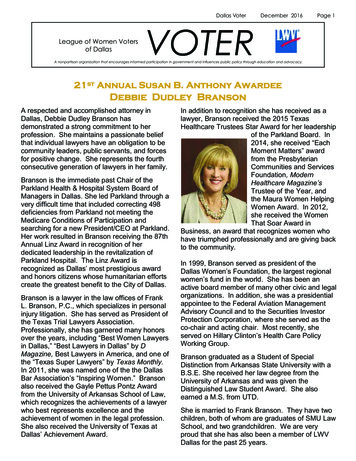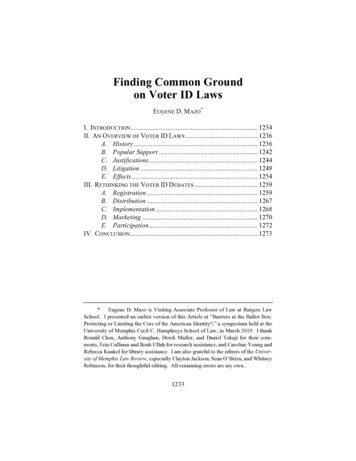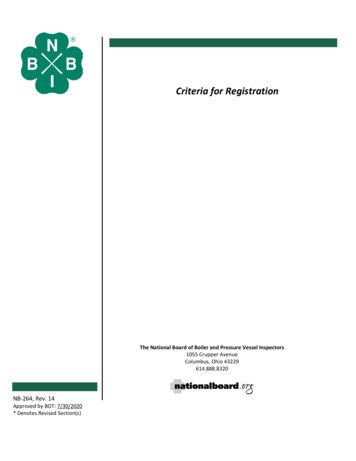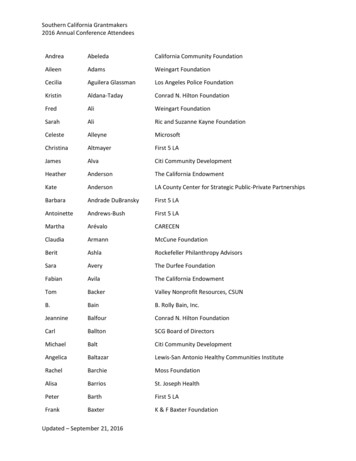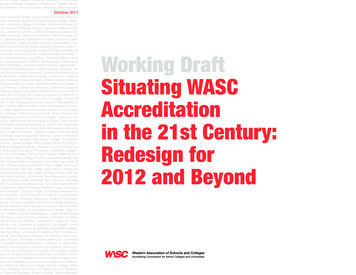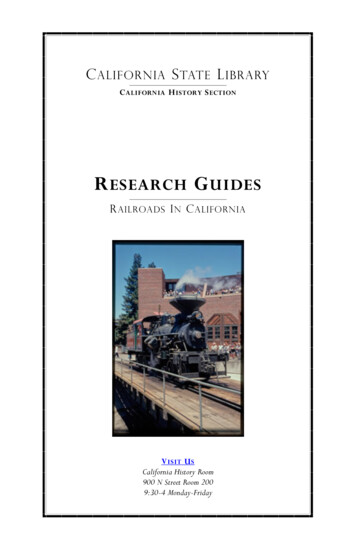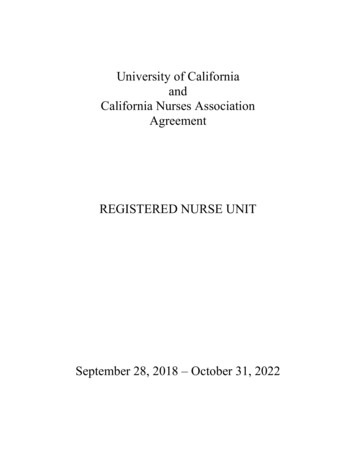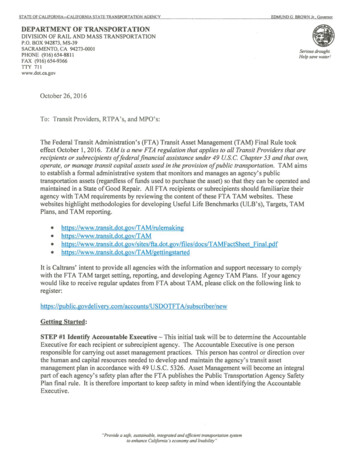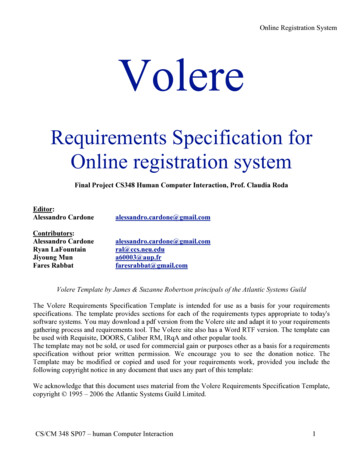
Transcription
California NationalVoter RegistrationAct ManualJANUARY 2021California Secretary of State
Chapter 1Executive SummaryThe NVRAThe National Voter Registration Act of 1993 (NVRA) was designed to increase thenumber of registered voters in the United States by requiring many government officesto offer people the opportunity to register to vote. The NVRA requires each state tooffer voter registration services at motor vehicle agency offices and, in addition, todesignate as voter registration agencies: All offices that provide public assistance;All offices that provide state-funded programs primarily engaged in providingservices to persons with disabilities; andOther state and local agencies.Beyond expanding opportunities to register to vote, the NVRA also protects the integrityof elections by requiring states to maintain accurate and current voter registration rolls.The NVRA specifically prevents states from removing voters from the rolls unlesscertain conditions are met and requires states to offer “fail safe” voting to registeredvoters who have moved within their county. California’s provisional voting laws meetNVRA requirements.The United States Election Assistance Commission (EAC) reports to Congress everytwo years on the impact of the NVRA. The EAC gathers data on the NVRA from statesby including questions about NVRA voter registrations and provisional voting in itsbiennial Election Day Survey of all 50 states. In California, the Secretary of Stateresponds to the EAC survey by gathering and compiling data from each of the 58county elections offices.Voter Registration at the Department of Motor VehiclesChapter Two of this manual covers NVRA voter registration services at the Departmentof Motor Vehicles (DMV). Under the NVRA, state motor vehicle departments must offervoter registration with each new, renewal, or change of address application for a statedriver license or identification card (DL/ID). Under the NVRA, DMV change of addressrequests serve as notice of a change of address for voter registration purposes, unlessthe voter chooses otherwise.In California, under the California Motor Voter program, every eligible applicant whovisits a DMV office to apply for or renew a DL/ID or to change an address isautomatically registered to vote, unless they choose to opt out of automatic registration.Additionally, every eligible applicant who receives a DL/ID renewal form online isautomatically registered to vote, unless they choose to opt out of automatic registration.Chapter 1 – page 1
During the automatic registration process, the applicant can register for the first time orre-register after a change in name, address, or party preference. This voter registrationinformation is sent electronically to the California statewide voter registration database,which then shares the information with county elections officials who update voterregistration records. Additionally, when a voter updates their address with a DMV officein California, this information is also provided to the statewide voter registrationdatabase.Moreover, every person who receives a DL/ID renewal form by mail also receives aCalifornia Voter Registration Application (VRC). The VRC can be used to register tovote or to re-register after a change in name, address, or party preference. Lastly, theDMV continues to accept completed VRCs and forwards them to the Secretary of Stateor the county where the voter lives.Voter Registration at Public Assistance Agencies, Disability Service Agencies,and Other Voter Registration Agencies in CaliforniaChapter Three of this manual covers voter registration services at public assistanceagencies, disability service agencies, and other agencies designated under the NVRA.The NVRA requires each state to designate as “voter registration agencies” all agenciesand offices that provide public assistance or are funded by the state primarily to servepeople with disabilities.Designated agencies must provide both an NVRA Voter Preference Form, which asks“Would you like to register to vote?” and a VRC to each person who applies for newservices or benefits, requests renewal or recertification, or identifies a change ofaddress. The NVRA requires designated agencies to ask the applicant to complete theVoter Preference Form and to keep all completed Voter Preference Forms on file fortwo years. If an applicant asks for assistance in completing a VRC, the NVRA requiresdesignated agencies to assist the applicant with filling out the VRC in the same mannerit assists applicants with filling out the agency’s own forms. Finally, designatedagencies must accept and forward completed VRCs to elections officials.California law goes a step further than the NVRA and requires that if an NVRA agencyallows applicants to apply online for services, they must also allow an applicant toelectronically submit a Voter Preference Form and voter registration application. AllNVRA agencies are provided their own unique URL for voter registration purposes.Registered Voter List Maintenance RequirementsChapter Four of this manual covers the NVRA requirements on how states maintainvoter registration rolls. California state election laws meet the NVRA list maintenancerequirements. Both the NVRA and state law provide for the: confirmation of voter registration sent to each newly registered voter or voter whoupdates their voter registration;Chapter 1 – page 2
removal of ineligible and deceased voters from the rolls;updating of a voter’s current registration if it is within California;cancellation of a voter’s registration if the:o voter confirms a change of residence outside California; oro county elections official receives notice from the U.S. postal service that thevoter appears to have moved, and the voter both fails to respond to anaddress verification postcard and fails to vote in two subsequent federalgeneral elections. In California, the county elections officials receive noticessuch as this via messages from the statewide voter registration database.In some cases, California law provides more opportunities to voters while remainingconsistent with the NVRA. For example, the NVRA requires states to accept voterregistrations up to 30 days prior to the election. Because California has a 15-day voterregistration deadline, elections officials accept voter registrations until 15 days prior toeach election.Additionally, California offers conditional voter registration (CVR) beginning on the closeof the registration up through and including Election Day. Voter registrations receivedafter the 15-day deadline that are not CVRs, are accepted for the purpose of registeringvoters for future elections, with the exception of registrations from new residents ofCalifornia and new United States citizens. Under California law, new Californiaresidents can register to vote up to seven days prior to an election. New United Statescitizens are eligible to register and vote up to the time polls close on Election Day.Provisional VotingChapter Five of this manual covers provisional voting, and encompasses the “fail safe”voting requirements under the NVRA. California provisional voting laws meet the NVRAfail safe voting requirements and the federal Help America Vote Act (HAVA) provisionalvoting requirements. California law gives any voter whose registration cannot beconfirmed at the polling place the right to vote using a provisional ballot. California lawalso allows for conditional voter registration (CVR) and CVR provisional votingbeginning on the close of registration up through and including Election Day at countyelections offices and other designated locations. California voters can also check MyVoter Status found on the Secretary of State’s website at https://voterstatus.sos.ca.gov/to see if their provisional ballot has been accepted.Recordkeeping and ReportingChapter Six of this manual covers state and county recordkeeping and reportingrequirements under the NVRA and HAVA. The EAC reports to Congress biennially onthe impact of the NVRA. To gather data for the report, the EAC surveys all 50 statesevery other year following the federal general election. The California Secretary ofState’s office responds to the EAC survey by gathering and compiling data from each ofthe 58 county elections offices. Counties report aggregate data on registration andvoting information, including but not limited to:Chapter 1 – page 3
total number of registered voters (active and inactive);total number of voters in the most recent federal election;registrations by type (new, valid, rejected, duplicate, re-registrations);registrations by source (mail, DMV, public assistance agencies, disability serviceagencies, armed forces recruitment offices, other NVRA designated agencies,and other sources);registration removals;military and overseas voters and vote-by-mail ballots transmitted and cast;provisional ballots cast; andregistration confirmation notices mailed, and responses received, under theNVRA list maintenance requirements.National Mail Voter Registration FormThe last chapter of this manual, Chapter Seven, covers the NVRA requirements toestablish the National Mail Voter Registration Form (National Form) and allow people toregister to vote by mail. The NVRA permits states to develop their own voterregistration forms but requires states to accept and use the National Form. California, aleader in mail registration and vote-by-mail voting, had already established mailregistration and vote-by-mail laws before the NVRA. (See Elec. Code, § 3000 et seq.)Enforcement of the NVRAThe NVRA authorizes the United States Department of Justice to bring a civil action infederal district court against states that do not comply with the NVRA. The NVRA alsoallows a person who believes they suffered harm due to a state or local failure toproperly implement the NVRA to sue a state or local agency. In most circumstances,private parties must first notify the chief elections official of the state and provide anopportunity for the state to correct the violation before filing a legal action. An individualor group who prevails in court may be awarded reasonable court costs and attorney’sfees. Finally, the NVRA establishes criminal penalties for certain intentional actsregarding registration, voting, or violation or denial of any other right under the NVRA.Implementation of the NVRA in CaliforniaCalifornia embraces the NVRA’s requirements and goals of helping more eligiblecitizens register to vote and cast ballots on Election Day by offering automatic voterregistration through the DMV; offering voter registration at state and local agencies,offering vote-by-mail and provisional voting; offering conditional voter registration;offering online voter registration at RegisterToVote.ca.gov; allowing counties to conductelections pursuant to the Voter’s Choice Act and utilize vote centers; and by maintainingaccurate voter rolls.Chapter 1 – page 4
California laws permitting voter registration by mail, vote-by-mail voting, and provisionalvoting, as well as laws setting voter list maintenance standards meet or exceed NVRArequirements. And although the NVRA did not require the adoption of state law to giveit effect, as more fully discussed in Chapter 3 of this manual, in January 2013, SenateBill 35 codified portions of the NVRA into state law and placed new requirements onNVRA agencies, county elections officials, and the Secretary of State. (See Elec. Code,§ 2400 et seq.)This manual is designed to help counties, as well as state and local agenciesdesignated as voter registration agencies under the NVRA, understand and carry outtheir NVRA duties. The Secretary of State also offers specific guidance and training fordesignated NVRA agencies on the Secretary of State website ion/nvra/training/.Chapter 1 – page 5
Chapter 2Voter Registration at Department of Motor Vehicles (DMV)Table of ContentsI.NVRA and California Elections Code Requirementsfor DMV Voter Registration .1II.DMV Forms and Procedures . . 2A.B.C.III.DL/ID Transactions at a Field Office . 21.Electronic DL/ID Application, Renewal, or Replacement –eDL44 and eDL44C . 22.Paper DL/ID Application, Renewal, or Replacement –DL44/DL44C . 33.Change of Address Form – DMV 14 . 34.DMV Voter Registration Card . 4DL/ID Transactions by Mail 51.DL/ID Renewal – DL6/DL410 FO . 52.Change of Address – DMV 14 . 5DL/ID Transactions Over the Internet . . 61.Driver License Internet Renewal (DLIR) . 62.Internet Change of Address (ICA) – DMV 14 . . 6Receipt and Processing of Electronic Voter Registration Informationby Elections Officials . 7A.Transmission of Electronic Voter Registration Informationto the Secretary of State . . 7B.Processing of Voter Registration Information by theSecretary of State and County Elections Officials . . 8Chapter 2 – page i
IV.Receipt of VRCs and Processing by County Elections Officials . 9A.B.Sources . 91.Local DMV Field Offices . 92.Secretary of State . . 93.Other Counties . 9Method and Frequency of Transmittal . 91.Local DMV Field Offices . . 92.Secretary of State . . 93.Other Counties . 9C. Processing VRCs . 9V.Training . 10VI.Resources and Monitoring . 10VII.Additional Information . 10A.Late Voter Registrations and Transmission Delays . . 10B.Minority Language Availability . 11C.DMV Mobile Units in Rural Counties . . 11Chapter 2 – page ii
I. NVRA and California Elections Code Requirements for DMV Voter RegistrationThe National Voter Registration Act of 1993 (NVRA) requires the Department of MotorVehicles (DMV) to provide voter registration services to people who apply for or renewa driver license or identification card (DL/ID). (52 U.S.C. § 20504(a).) In addition,unless the DMV customer indicates that the voter registration address should not beupdated, any change of address form submitted for a DL/ID will also serve as a noticeof change of address for voter registration purposes. (52 U.S.C. § 20504(d).)Pursuant to the NVRA, certain information provided in the voter registration applicationreceived by the DMV remains confidential. Specifically, an applicant’s decisionwhether to register to vote, and the office at which the voter registration took place,must be kept confidential and may not be used for any purpose other than voterregistration. (52 U.S.C. § 20504(c)(2)(D)(iii).)The NVRA provides that “a completed voter registration portion of an application for aState motor vehicle driver’s license accepted at a State motor vehicle authority shallbe transmitted to the appropriate State election official not later than 10 days after thedate of acceptance,” and that “[i]f a registration application is accepted within 5 daysbefore the last day for registration to vote in an election, the application shall betransmitted to the appropriate State election official not later than 5 days after the dateof acceptance.” (52 U.S.C. § 20504(e)(1), (2).)The California New Motor Voter Program was enacted in 2016 and took effect in 2018.(Elec. Code, §§ 2260-2270.) Under this program, eligible DMV customers completingan original or renewal DL/ID application, or a change of DL/ID address transaction,will automatically have their voter registration information transmitted to the Secretaryof State. Eligible DMV customers will be registered to vote unless they opt out of voterregistration during their DMV transaction. 1Californians are eligible to vote if they are 18 or older and: A United States citizen and a resident of California, Not currently serving a state or federal prison term for the conviction of a felony,and Not currently found mentally incompetent to vote by a court.Voter pre-registration is available through the DMV for Californians who are 16 or 17years old and meet the other eligibility requirements. They will automatically beregistered to vote when they turn 18.In accordance with California State Assembly Bill 60 (“AB 60”), Stats. 2013, Ch. 524, DMV is authorizedto issue a DL/ID without receiving satisfactory proof that the applicant’s presence in the United States isauthorized under federal law. Customers applying for or renewing a DL/ID under AB 60 will not bepresented with the option to register to vote, if using an electronic form or a paper form that has been prepopulated with their information. Regardless of the type of form these customers use, or even if they aresubmitting change of address information, these customers will not have their information transmitted tothe Secretary of State.1Chapter 2 – page 1
The following registration services are provided by DMV, in connection with DL/IDapplications or changes of address: An electronic Driver License and ID Card Application (eDL44 and eDL44C)containing the voter registration application that can be completed online prior tovisiting a field office, or during a field office visit at a touch screen terminal or ADA(Americans With Disabilities Act) station. Paper and electronic change of address forms for DL/ID purposes (DMV 14) thatserve as a notice of change of address for voter registration purposes, unless thecustomer indicates otherwise on the change of address form. These forms alsocontain a voter registration application. For eligible licensees or card holders, paper DL/ID Renewal by Mail applications(DL 410 and DL 6) contain a voter registration application. Paper Voter Registration Cards (VRCs) in field offices for customers who want toregister to vote but who are not applying for, renewing, or changing an address fora DL/ID. VRCs are also provided to customers who are unable to complete theirDL/ID transaction in the field office due to a system outage, and who request aVRC. Secure and timely electronic transmission to the Secretary of State of registrationinformation collected from DL/ID applications and change of address forms. Timely delivery of completed paper VRCs to the county elections officials. Voter registration information and a link to the Secretary of State’s website on theDMV’s website. Referral to the Secretary of State or county elections officials when customersinquire regarding their voter registration status. DMV cannot provide thisinformation to the customer.II. DMV Forms and ProceduresA. DL/ID Transactions at a Field Office1. Electronic DL/ID Application, Renewal, or Replacement – eDL44 andeDL44CThe electronic application form for a DL/ID is the eDL44. For commerciallicense applications, the form is called the eDL44C. A voter registrationapplication is part of these electronic forms. These forms can be completed bycustomers in the field office on special touch screens when applying in person.Alternatively, these forms can be completed at home, prior to a visit, byaccessing them online.On the eDL44 and eDL44C forms, if the customer does not answer “Yes” to thecitizenship and other voter eligibility questions, the customer is not presentedChapter 2 – page 2
with the voter registration portion of the electronic application and
o county elections official receives notice from the postal serviceU.S. that the voter appears to have moved, and the voter both fails to respond to an address verification postcard and fails to vote in two subsequent federal general elections. In California
